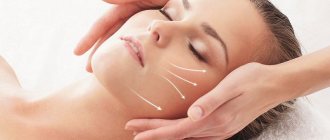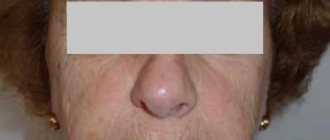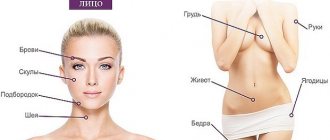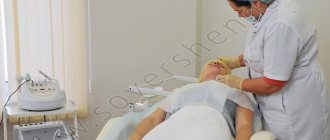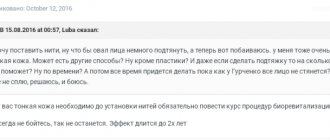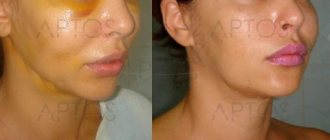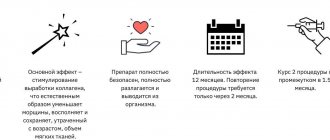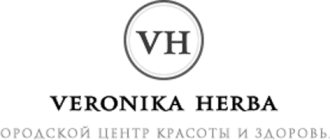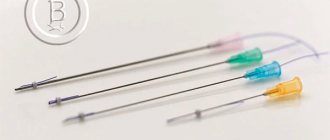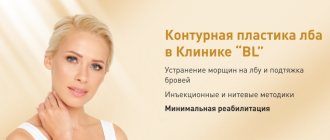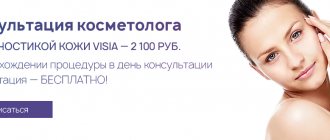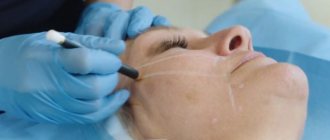Thread lifting is a minimally invasive, effective cosmetic procedure that involves the subcutaneous implantation of materials biocompatible with the human body to reinforce soft tissues. The technique is an excellent alternative to radical surgery, as it is characterized by a minimum of post-procedural complications and short recovery times. To correct age-related changes, different types of threads are used, which are selected individually for each client. The technique demonstrates excellent results for patients aged 35–50 years. The effect of a thread facelift lasts for several years. Cosmetologists at the International Hemostasis Clinic use proven, certified material for thread lifting, guaranteeing each client the most positive results and no side effects.
Types of threads
Facial thread lifting is a minimally invasive anti-aging procedure that uses non-absorbable or absorbable fibers. The first ones remain under the skin after implantation, maintaining a reinforcing effect for 5 to 7 years. Over the course of several months, the absorbable threads gradually dissolve and are removed from the body, and in their place a reliable framework or collagen and connective tissue remains. This frame holds soft structures in a given position, preventing the development of gravitational ptosis. The effect of using self-absorbable threads lasts up to 2 years.
Modern cosmetology clinics use the following types of threads for thread lifting:
- Smooth. They are an absolutely smooth fiber made of silicone, polyurethane, and polyamide. The material does not dissolve and is implanted into the deep layers of the skin, guaranteeing a serious tightening even in cases of severe ptosis. The introduction of smooth threads requires cutting the skin, so the procedure should only be performed by an experienced cosmetologist.
- Mesothreads. They are absorbable threads that dissolve independently 6 months after implantation. The introduction of fibers is carried out with a special blunt-tipped needle, which does not injure the soft tissues, but only pushes them apart. Mesothreads are prescribed to patients aged 35–40 years as a preventive measure for the development of the first age-related changes. The lifting effect lasts 1.5 – 2 years.
- Combined. Lifting threads with notches, made of degradable polypropylene, have 8–11 cones and nodules along their entire length, which self-resolve within 6–8 months after the procedure. In their place, connective tissue is formed, providing a reliable tightening and reinforcing effect.
- Gold. Made from polyglycol coated with gold. Gold threads do not dissolve over time; after implantation, they stimulate the production of collagen, which forms a reliable frame and provides a pronounced lifting effect. The results of the procedure last for 5 – 7 years. After implantation of gold fibers, it is contraindicated to use the services of hardware cosmetology.
Mesothreads: negative reviews, photos
Experienced cosmetologists and plastic surgeons who have the skills to implant reinforcing and lifting threads almost never use ordinary thin mesothreads in their practice. The latter are widely used in cosmetology only because of the simplicity of the procedure, while the installation of reinforcing and lifting threads is too complicated and ideally requires a doctor with a surgical background.
Therefore, most cosmetologists do what they can do (without requiring complex manual skills), namely mesothreads. Therefore, if you want to install lifting threads rather than meso-threads, you should only contact plastic surgery clinics for this. As for reinforcing threads, their installation can be done either traditionally or using the “loop” technique, which can give this type of threads lifting properties. In the latter case, it is probably also better if the threads are installed by a plastic surgeon rather than an ordinary dermatocosmetologist.
Mesothreads: pros and cons... based on experience, only less than 10% of patients are satisfied with the results. Most often you see the following picture: trying to see the result of thread implantation, the patient looks at himself in the mirror with doubt on his face, while the doctor persistently repeats: “Well, you see how good it has become.” Most patients claim that the lifting and rejuvenation effect was either completely absent or was so implicit that it was not worth the money spent.
All you can count on when implanting mesothreads is an improvement in skin color, turgor and skin hydration (and then only if you preferably have a fine-wrinkled type of aging). For comparison, below we have posted photos of patients before and after installation of reinforcing/lifting threads -
Benefits of thread lift
Thread lifting has many advantages:
- painlessness ensured by the use of local anesthesia;
- short rehabilitation period;
- minimal risks of developing post-procedural complications;
- the result can be assessed immediately, over time the effect becomes even stronger;
- low-injury;
- maintaining natural facial expressions;
- compatibility with plastic surgery;
- After the service life has expired, the procedure can be used again without risk to health.
Advantages and disadvantages
The cosmetic method has a number of advantages, but it is important to know the disadvantages of the procedure. A cosmetologist may prescribe thread lifting after assessing the condition of the skin.
Reinforcement can improve lymphatic drainage only in the initial stages; with pronounced age-related changes, an integrated approach is required.
Pros of coggy:
- the result is achieved in 1 procedure;
- the effect lasts from 3 to 5 years;
- the material is not rejected by tissues;
- maintaining natural facial expressions;
- Possibility of use for the face, neck, body;
- has a cumulative effect;
- low morbidity;
- short recovery period;
- combined with other hardware and injection procedures;
- correction requires a minimum number of threads.
Minuses:
- high price;
- some patients feel pain and discomfort;
- the result depends on the doctor’s experience;
- has age restrictions.
Indications for thread face lifting
Thread lifting is prescribed to patients aged 35–50 years as a preventive measure against aging and aging of the skin, as well as gravitational ptosis of soft tissues. Indications for the procedure:
- formation of wrinkles and creases in the forehead, between the eyebrows;
- deep wrinkles in the nasolabial triangle area;
- gravitational ptosis, double chin, change in facial contour;
- drooping of eyebrows, cheeks, cheekbones.
Infectious and inflammatory complications
The greatest danger to the patient’s health is posed by infectious and inflammatory complications of thread rejuvenation procedures. Their obvious connection with the design of the threads can not be traced, with the possible exception of braided threads in a sheath and polydioxanone mesothreads with a fleecy surface. With inflammation in the implantation area, such threads can contribute to the formation of a persistent focus of infection.
Inflammation is caused by the penetration of infection under the skin during the installation of threads or during the rehabilitation period. Its development can be facilitated by various factors - a general somatic disease, an infectious process in the body (herpes, etc.), the presence of an inflammatory focus (unsanitized teeth, etc.), reduced immunity.
The easiest and most common infectious complication is inflammation of the skin at the sites where needles and cannulas are inserted. In isolated cases, severe forms occur (Fig. 5).
| A | B |
Rice. 5. Infectious and inflammatory complications of thread lifting: A – cheek abscess; B – blockage of the salivary gland duct with infection, leakage of saliva through the fistula. Inflammatory swelling of the buccal area
Features of the inflammatory process depend on the correction area. The most risky areas for the development of complications are the behind-the-ear area, the red border of the lips and the scalp.
The behind-the-ear area is one of the dirtiest areas not only of the head, but of the entire body. Accumulating dirt, mixing with the secretion of the sebaceous glands, creates a favorable environment for the proliferation of microorganisms. This area is hidden from view and is often forgotten when carrying out personal hygiene.
During the procedure, the mastoid process, located in the postauricular area, is used to fix the threads. During the rehabilitation period, not all patients follow the doctor’s recommendations for treating wounds. The skin under the scabs itches, and patients tear them off, causing infection. Hence, there is an increased risk of developing various inflammatory processes.
Another problem area is the red border of the lips; here the herpes virus is often present in a dormant state. Passing the thread in close proximity to it provokes an exacerbation of herpes, and in the future a secondary infection may occur.
When using a fixation point in the scalp (usually in the area of the temporal ligament), there is a possibility of hair getting into the wound and, along with it, infection. Other areas of the face and body also have their own, albeit smaller, risks of inflammation. The doctor should be sufficiently aware of them.
When treating infectious and inflammatory complications, local and (or) general antibiotic therapy is used. If there are small inflammatory elements in the area where the thread extends beyond the skin, the end sections of the threads are cut off and an ointment containing antibiotics is applied to the area of inflammation. Inflammation along the entire course of the thread is an absolute indication for its removal. This manipulation is usually not difficult (Fig. 6).
Rice. 6. Removing the thread
If the thread is monofilament, then in the presence of a local focus of inflammation, local use of antibiotics most often leads to complete relief of the inflammatory process. If the thread is braided in a sheath (for example, Spring Thread), then under the influence of antibiotics there is a temporary subsidence of the process, but when the drug is discontinued, foci of inflammation may appear again, anywhere along the thread. Removing the braided thread is a prerequisite for stopping the inflammatory process.
Abscesses and phlegmons are opened, washed with an antiseptic solution and drained. As the infectious process progresses and becomes widespread, the purulent focus is eliminated and general treatment is carried out, similar to intensive therapy for sepsis.
Contraindications to the procedure
Thread reinforcement is not prescribed to patients diagnosed with the following diseases:
- oncology;
- acute infectious and viral processes;
- diseases of the hematopoietic system;
- hormonal, endocrine disorders;
- decompensated diabetes mellitus;
- autoimmune disorders;
- congenital or acquired immunodeficiency;
- cardiovascular pathologies;
- renal, liver, pulmonary failure;
- somatic and mental disorders;
- tendency to form keloid or hypertrophic scars.
The procedure is contraindicated for women during pregnancy, lactation, and menstrual bleeding. Thread lifting is prohibited for patients with individual intolerance to the components of the material.
Prevention of complications
Not all complications of thread rejuvenation methods are related to the design of the thread and the technique of performing the procedure. Thus, the most important risk factor for infectious complications is violation of the rules of asepsis and antisepsis. These rules are regulated by SanPiN 2.1.3.2630-10 [19].
Thread methods of rejuvenation are used at least in a treatment room, with good lighting. Before the procedure, the room is quartzed. When preparing the procedure table, lay out threads, sterile instruments, sterile wipes, and an antiseptic solution on a sterile sheet without touching it with your hands.
When preparing the patient for the procedure, make-up is removed not only from the correction area, but also from adjacent areas. The correction area is treated with skin antiseptics - such as betadine, an alcohol solution of chlorhexidine, AHD 2000. When installing threads in the soft tissues of the face, the procedural field is limited to adhesive bandages in the scalp area to prevent hair from getting into the wound and hair coming into contact with the threads. If there is a thread fixation point in the scalp, the skin area in the puncture area is shaved, and the adjacent areas with hair are treated with betadine, which, in addition to antiseptic properties, has adhesive ability. The doctor performs the procedure in a gown, mask and gloves, which must be sterile.
Other risk factors are also significant, such as the doctor’s insufficient consideration of indications and contraindications for the procedure, the use of low-quality threads, and the patient’s non-compliance with the doctor’s recommendations [15, 20].
As for taking into account contraindications, it is unacceptable to carry out the procedure in the presence of inflammatory processes (pustular rashes in the form of acne, boils, inflamed scratches, especially from pets) in the area of correction and, importantly, in the immediate adjacent areas. The procedure for implanting threads should also be excluded if the general somatic status of the patient is disrupted (acute infectious diseases, signs of deterioration in the functioning of the immune system).
The risk of complications is significantly reduced with proper quality control of the threads by the doctor. The doctor must check the presence of a registration certificate from the Ministry of Health of the Russian Federation for a medical device, the expiration date of the threads, the integrity of the packaging, and be aware of the storage conditions of the threads.
Much depends on the course of the rehabilitation period. The doctor gives the patient recommendations that must be followed. After the installation of certain types of threads with high wickability, according to the protocol, prophylactic antibiotics are required. Other recommendations mainly boil down to eliminating mechanical, thermal and chemical effects on the correction area, as well as preventing infection from entering wounds.
The principle of operation of face lift with threads
After implantation, connective tissue is formed around the threads, which acts as a framework that eliminates sagging of the soft tissues. In addition, collagen synthesis is activated, due to which noticeable rejuvenation of the skin and smoothing of wrinkles occurs. Even after the fibers are absorbed, the resulting reinforcing frame remains. It provides a pronounced lifting effect and is an excellent prevention of the development of gravitational ptosis and the formation of the first age-related defects.
How does the thread facelift procedure work?
Thread reinforcement includes the following steps:
- Preparation. The procedure is carried out in a cosmetology salon. Before implantation, the specialist cleanses the skin of decorative cosmetics and impurities, then treats the skin with a bactericidal solution that destroys pathogenic microflora that contribute to infection and inflammation.
- Anesthesia. For pain relief, a local anesthetic is mainly used, but sometimes the cosmetologist uses general anesthesia.
- Marking of injection points. The cosmetologist, using a special marker, marks in advance the points where the threads will be inserted.
- Fiber implantation. As soon as the anesthesia takes effect, the specialist, using a special needle or cannula, makes a micro-puncture, implanting threads to a certain depth. The fibers are fixed in the required position and stretched in the direction opposite to the needle.
- Repeated treatment with anesthetic. At the end of the procedure, the insertion sites of the cannulas or needles are re-treated with a bactericidal solution.
- Applying a soothing compress. At the very end, the cosmetologist applies a cold compress to the treatment areas, which relieves inflammation, swelling and prevents the formation of bruises.
Iatrogenic complications
If iatrogenic complications are considered in a narrow sense - as a doctor’s mistake when performing a procedure, then they mainly come down to the incorrect use of the technique for installing threads.
It is known that the installation of threads with protrusions is effective only in kinetically inert zones [5]. However, if the correction zones are chosen unreasonably, the thread may pass through the moving parts of the face. Violation of the general rules for installing threads - irrational choice of the fixation point, exit point, depth of the thread can lead to damage to the blood vessel, injury or compression of the nerve, and disruption of the integrity of other structural formations of the face and body [18]. According to the experience of our clinic’s specialists, a deeply located thread promotes protrusion of the tissue, while a superficially located thread, on the contrary, causes depression. The doctor’s ignorance of this pattern due to his lack of qualifications can cause cosmetic defects (Fig. 7).
| A | B |
Rice. 7. Violation of the rules for the depth of insertion of the cannula: A – skin retraction due to superficial insertion of the end sections of the threads; B – restoration of facial contours immediately after removal of the end sections of the threads
The doctor's qualifications are the most important factor. M.A. Sulamanidze et al. We are confident that the main reason for complications and unpleasant consequences is the lack of special training among doctors [5]. The Society of Specialists in Medical Thread Technologies (OSMNT) is actively involved in solving this pressing problem, providing additional professional training for doctors at the North-Western Educational Medical Center. Lectures, master classes, round tables and seminars on traditional and new methods of thread rejuvenation lay the foundations for high-quality procedures, treatment and prevention of complications.
At what age should you have a face lift with threads?
The first signs of sagging soft tissues are observed after 30 years. Therefore, starting from this age, you can resort to thread lifting with mesothreads. After 40, it is advisable to reinforce with absorbable fibers, in place of which a reliable frame of connective tissue is formed that holds the soft structures in the required position. Non-absorbable threads are recommended for clients over 50. They effectively eliminate the signs of gravitational ptosis and provide noticeable rejuvenation. After 60, a facelift with threads will not give the desired effect. At this age, it is more advisable to resort to more radical anti-aging procedures.
Opinion of cosmetologists
On forums, cosmetologists share their experience of working with kogi mesothreads.
The review states that if fibrosis forms , it means that low-quality material was used, or the patient has a connective tissue disease.
A participant writes about the effect of mesothreads on a slight overhang of the middle third of the face.
The user asks which threads are best to work with and where to get training.
Recovery period after facelift with threads
Rehabilitation can take from 2 to 6 weeks. It all depends on the type of threads used, the depth of their implantation, and the individual characteristics of the patient’s body. The rules of rehabilitation are simple:
- During the first 2–4 days, try not to touch your face, avoid contact with water, and limit facial movements.
- To eliminate swelling and speed up the resorption of hematomas, it is recommended to apply cold compresses based on decoctions of chamomile, calendula, and sage daily, 2–3 times a day. If you are experiencing severe pain and discomfort, your doctor will prescribe painkillers.
- You are allowed to sleep only on your back, with a high pillow under your head.
- Throughout the entire rehabilitation period, avoid alcoholic beverages, hot, spicy, and salty foods.
- Minimize physical activity.
- Refuse to visit the swimming pool, bathhouse, sauna, solarium.
- Until complete healing, do not use decorative cosmetics and do not resort to cosmetic procedures such as pling, scrubbing, massage.
Mesothreads: price for 2022
For mesothreads for face lifting, the price will depend on the type of thread, as well as their quantity. As we said above, the cheapest cost is the smooth linear type of PDO thread (about 110 rubles for 1 thread). But in the clinic, the price for installing 1 such thread will already be about 900 rubles, but if the patient plans to install a large number of threads, then, based on their quantity, the price of mesothreads can be reduced to approximately 600 rubles for 1 thread.
Threads made from a copolymer of L-lactide with caprolactone will always be a priori more expensive than threads made from PDO, so the cost of 1 thread of the “Aptos Nano Vitis-4” type will be about 1,500 rubles. When installing Screw and Double Screw threads from PDO, you should focus on the same 1,500 rubles for 1 thread. As for GOG type threads, the highest quality ones will have a higher cost and, accordingly, their price usually starts from 2300 rubles for 1 thread. Below you can read reviews of thread lifting with mesothreads.
